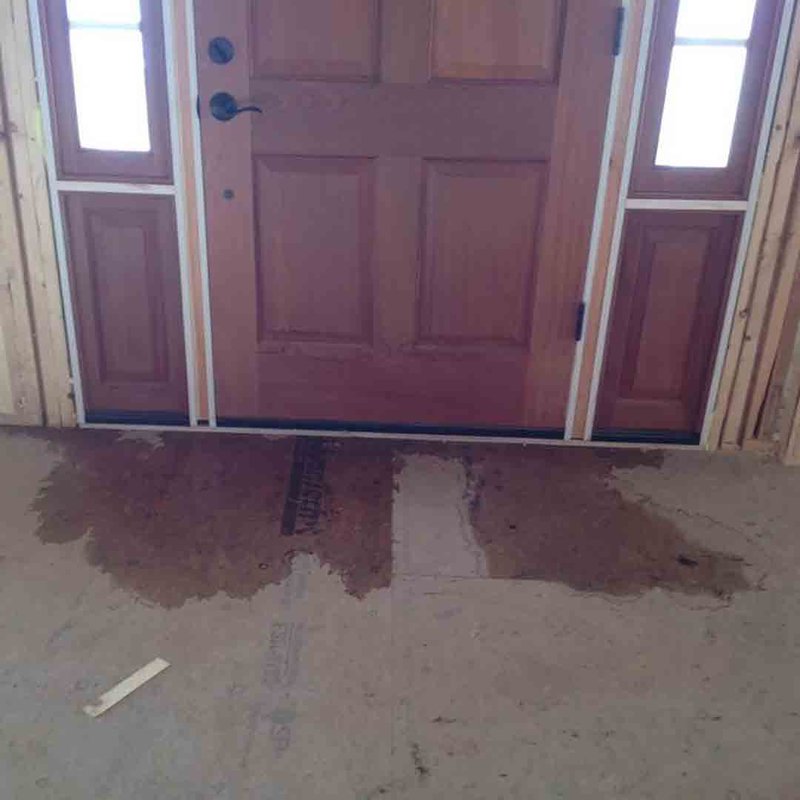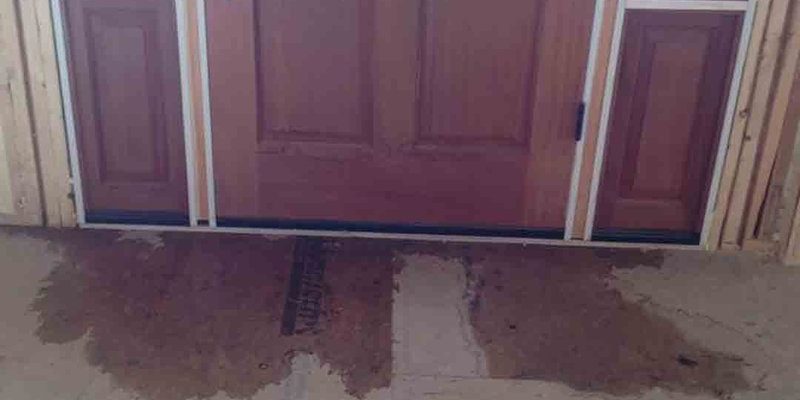
A leaky exterior door—whether it’s a Therma-Tru fiberglass entry, a Pella steel door, or even a basic wood slab from your local store—doesn’t always mean poor quality. It almost always comes down to small things: tiny gaps, missing or damaged seals, or problems with how the door meets the floor. Let’s break down exactly why those leaks happen, what to look for, and how to get your entryway sealed up tight again.
Common Reasons Water Leaks Under Exterior Door Thresholds
Honestly, the biggest culprit for water sneaking under an exterior door is gravity mixed with bad timing. When heavy rain falls against your house, water wants to move from high spots to low spots—like under your door threshold. You might be wondering, “But isn’t the threshold supposed to stop that?” It is, but even the best thresholds can fail if something’s out of place.
- Worn or Damaged Weatherstripping: Weatherstripping creates a seal between your door and the frame. Over time, it can get squished, ripped, or just lose its bounce. Once that happens, rainwater slides right through the gaps.
- Poor Threshold Alignment: If your door doesn’t sit flat on the threshold—maybe it’s sagging, or the threshold is warped—that small space is all water needs to creep inside.
- Improper Slope: Your threshold needs to slope slightly away from your home, so water runs off. If the slope is flat or, worse, tilting inside, rain can collect and seep in.
- Missing or Bad Sealant: The seams where your threshold meets the door frame and floor are usually caulked or sealed. If that stuff cracks or pulls away, rain finds a way right through.
Just like a remote control that stops syncing because the battery is loose or the code is wrong, a leaky threshold is often a tiny fix—but you have to spot the real problem first.
How Heavy Rain Makes Leaks Worse
Here’s the thing about heavy rain: it doesn’t just pour down, it sometimes blows sideways. So, if your door faces the wind or sits in a low spot, you’re likely to see more water under the threshold. Even a perfectly fine threshold can get overwhelmed if water pools outside your door during a downpour.
When the rain is steady, it can expose weaknesses you never noticed before. For example, if you spot water only after a thunderstorm, you might have a problem that only shows up under stress. That’s similar to a universal remote working fine with one TV, but refusing to pair with another when you need it most.
Sometimes, water even gets inside the door itself. Poorly sealed doors—especially wood or older fiberglass—can soak up water at the bottom, swell, and make the leak worse next time. If the door doesn’t open and close properly, that’s a sign to look for.
The Role of Threshold Design and Door Type
Not all exterior doors and thresholds are built the same way. Some brands put extra effort into sealing, while others keep things basic. A modern Pella door, for example, might come with a built-in adjustable threshold and tight gaskets. Meanwhile, some builder-grade units just have a thin piece of rubber that wears out in a season.
Thresholds also come in different shapes—some are raised, others are barely above floor level. If your threshold is low and flat, it’s more prone to letting water in because there’s just less “wall” for the water to climb. Even the best seal can have trouble if the design isn’t meant for your climate.
If you’ve replaced your door recently and still have leaks, check if the installer used the right threshold for your doorway and climate. Sometimes, swapping in a threshold with a better slope or installing a sill pan makes all the difference. It’s a bit like choosing the right battery size for your remote—little details matter.
Installation Problems That Lead to Door Leaks
Even the highest-rated exterior doors won’t keep out water if they’re installed badly. Most leaks trace back to errors during installation—sometimes it’s the threshold, other times it’s the whole frame.
- No Sill Pan: A sill pan is a hidden tray (usually plastic or metal) that sits under the threshold. It helps direct stray water back outside. If your door was installed without one, any leak turns into a puddle fast.
- Improper Sealant: Installers should use flexible, waterproof caulk around all seams and joints. Missing one spot is all it takes for water to find a path inside.
- Misaligned Door or Threshold: If your door sags, or the threshold isn’t level, you’ll get uneven gaps. Water will always find—and use—the biggest gap it can.
It’s like programming a remote without finishing all the setup codes—one skipped step, and it just won’t work right. If you’re not sure how your door was installed, it may be worth pulling up a corner of the threshold or checking under the weatherstripping for gaps or missing sealant.
How to Diagnose Where the Leak Starts
So, how do you figure out exactly where the water is getting in? Start with simple detective work. Dry everything off inside and wait for the next heavy rain. Watch closely to see where the first drops appear—at the corners, in the middle, or along the side.
Common patterns:
- Corners: Usually means a sealant or caulk problem, especially where the threshold meets the frame.
- Center of the threshold: Could point to worn weatherstripping or a threshold that’s too low or missing gaskets.
- Edges of the floor: Sometimes water sneaks under the sides, especially if siding or flooring is cut too close to the door with no sealant.
You might want to run a “reset” by gently pouring water outside the door with a watering can, then checking inside every few minutes. Use paper towels or tissue at the threshold—if they get wet, you know you’ve found part of the leak.
It’s a little like troubleshooting a remote: rule out one factor at a time until you find the issue. Don’t forget to look outside, too. If your porch or walkway is sloped toward the door, re-grading the area may be a part of your fix.
Simple Fixes for a Leaking Exterior Door Threshold
Once you know what’s causing the leak, you can usually make a big improvement with some DIY fixes. Let me explain a few easy steps:
- Replace Weatherstripping: Remove the old strip and install new, high-quality foam or rubber weatherstripping. Make sure it forms a tight seal when the door closes.
- Add or Re-caulk Sealant: Use a waterproof, paintable exterior caulk around the edges of the threshold, especially at the corners and under any gaps.
- Adjust the Threshold: Some thresholds have screws that let you raise or lower the height. Tighten until the door seals, but still swings freely.
- Install a Door Sweep: Attach a rubber or vinyl sweep to the bottom of the door—this blocks water and wind from slipping under.
If you’re dealing with a serious or recurring leak, consider calling a pro who can check the slope, look for missing parts like a sill pan, or recommend a better threshold.
When a New Door or Threshold Makes Sense
Sometimes, an older threshold or exterior door is just too far gone for quick fixes. If you see rot, warping, or major cracks, you may need an upgrade. Modern doors from brands like Therma-Tru and Pella have much better weatherseals and gaskets than older models.
A big advantage of new doors is that they’re designed with climate in mind—offering better code compliance and protection. If your door or frame is damaged (think: swollen wood, split jambs, aluminum thresholds flattened by years of wear), a total replacement might be the only way to stop the leaks for good.
Switching to a new threshold or door is a bigger project, but it pays off in peace of mind. Just like syncing a new remote that finally works every time, the right replacement keeps your entry dry, efficient, and secure.
Preventing Future Leaks: Best Practices
Keeping water out of your home isn’t a one-time job—it’s more like regular maintenance. Here are a few habits to help keep your threshold leak-free:
- Check Weatherstripping Twice a Year: Look for cracks, gaps, or flattening, and swap it out if it’s looking tired.
- Inspect Sealant and Caulk: Run a finger along the threshold seams. If you feel crumbling or notice missing bits, reapply exterior-grade caulk.
- Clean Thresholds and Drains: Sweep away leaves, dirt, and debris that could trap water near your door.
- Watch for Settling or Sagging: Houses do move a little over time. If your door suddenly starts dragging or you notice daylight under it, check the threshold and frame for movement.
If you ever need to reset, adjust, or troubleshoot your door like you would a remote control, don’t hesitate. Catching these issues early goes a long way toward keeping your home dry and your repairs affordable.
The bottom line: Leaking under your exterior door threshold in heavy rain isn’t just bad luck—it’s a sign that something small needs fixing. With a careful look, a few simple tools, and the right replacement parts, you can keep water outside where it belongs.
Dealing with a wet entryway can be annoying, but it’s also a nudge to give your door some attention. Whether you patch things up or decide it’s time for a new threshold, every step you take keeps your home safer and more comfortable—rain or shine.
